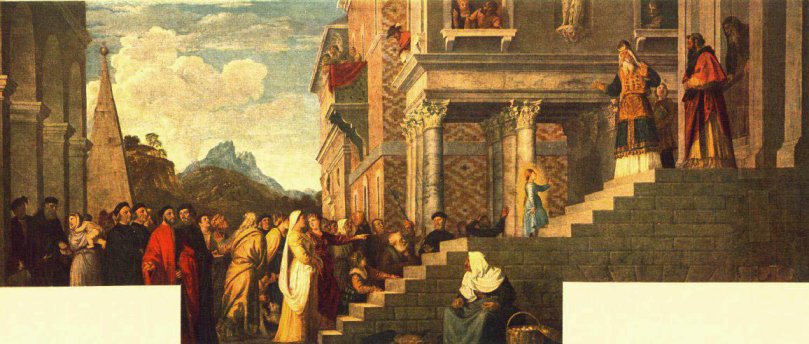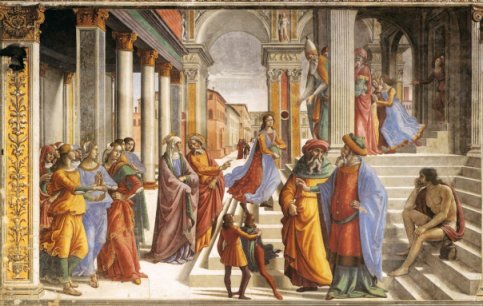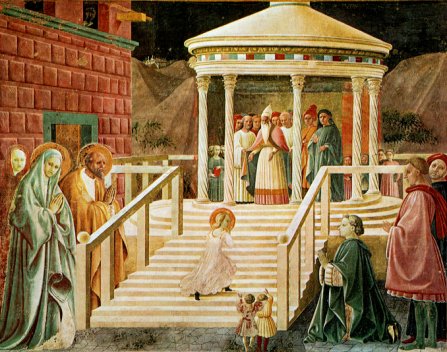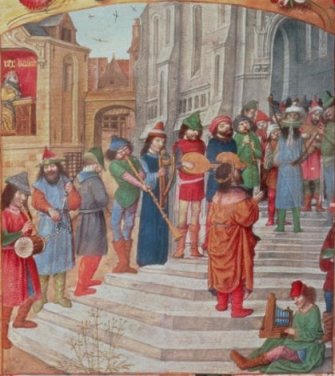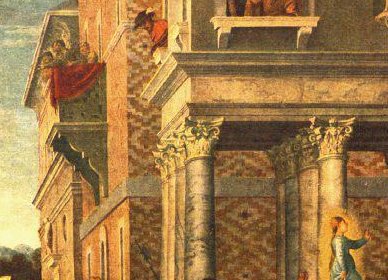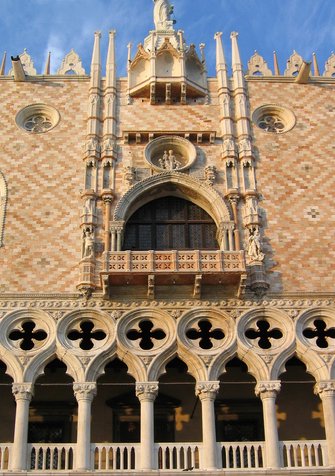|
|
|
|
|
|
|
Visitors to Venice rarely wander more than 500 yards from the Piazza San Marco or the Rialto. The result is that some of the most beautiful churches in the city get only a trickle of visitors. A favourite of mine is Madonna del Orto, near the north coast in the far reaches of Canareggio. Anywhere else, this church, full of Tinteretto masterpieces, would be a major tourist attraction. Tintoretto's version of The Presentation of the Virgin at the Temple is high up on the wall. This may make it little difficult to see, but if ever a painting needed to be seen from a low viewpoint it is this one. |
|
|
|
|
|
We will return to the Tinteretto
shortly - there is a good deal to say about it. Before doing so let's look
at the background to the story of the Virgin's arrival at the
temple. In contrast with its treatment of other episodes, The Protovangelium does not linger here: '(When) the child was three years old, and Joachim said: Invite the daughters of the Hebrews that are undefiled, and let them take each a lamp, and let them stand with the lamps burning, that the child may not turn back, and her heart be captivated from the temple of the Lord. And they did so until they went up into the temple of the Lord. And the priest received her, and kissed her, and blessed her, saying: The Lord has magnified your name in all generations. In you, on the last of the days, the Lord will manifest His redemption to the sons of Israel. And he set her down upon the third step of the altar, and the Lord God sent grace upon her; and she danced with her feet, and all the house of Israel loved her.' The Golden Legend is more interesting, if rather more cryptic: 'When she was weaned at the age of three, the parents brought her to the Lord's temple with offerings. Around the temple there were fifteen steps, corresponding to the Gradual psalms, and because the temple was built on a hill there was no way to go the altar, which stood in the open, except by climbing the steps. The virgin child was set down at the lowest step and mounted to the top without help, as if she were already grown up.' This seems to be based on a different apocryphal text, known as the Pseudo-gospel of Matthew: After these things, her nine months being fulfilled, Anna brought forth a daughter, and called her Mary. And having weaned her in her third year, Joachim, and Anna his wife, went together to the temple of the Lord to offer sacrifices to God, and placed the infant, Mary by name, in the community of virgins, in which the virgins remained day and night praising God. And when she was put down before the doors of the temple, she went up the fifteen steps so swiftly, that she did not look back at all; nor did she, as children are wont to do, seek for her parents. Whereupon her parents, each of them anxiously seeking for the child, were both alike astonished, until they found her in the temple, and the priests of the temple themselves wondered. (Chapter 4) These descriptions, with the fifteen steps, were taken on by a range of painters. Not all managed 15 steps - that is quite tricky to manage in a simple painting design - but many did. |
|
|
|
|
|
|
|
|
|
|
|
So why fifteen steps, and what has that to do with the Gradual psalms? In the Authorised version the Gradual psalms number 15: from 120 to 134. These are sung at the 'Gradual' of the Mass, preceding the reading of the gospel. They are sometimes know as the songs of ascent, or the songs of degrees. In Jewish tradition, these were the psalms sung at the Temple at Jerusalem on the return from the Babylonian exile. Haydock's Bible Commentary (1859) puts it thus: 'The following psalms, in number fifteen, are called gradual psalms or canticles, from the word gradus, signifying steps, ascensions, or degrees; either because they were appointed to be sung on the fifteen steps, by which the people ascended to the temple; or that in the singing of them the voice was to be raised by certain steps or ascensions: or that they were to be sung by the people returning from their captivity, and ascending to Jerusalem, which was seated amongst mountains. The holy Fathers, in a mystical sense, understand these steps, or ascensions, of the degrees by which Christians spiritually ascend to virtue and perfection; and to the true temple of God in the heavenly Jerusalem.' According to a
musical friend, it is possible to sing the psalms at a gradually rising
pitch, but only if the first psalm starts low enough! |
|
|
|
|
|
At this point, we need to introduce St Jerome in to
the picture. He had much to say about the psalms, and about the Temple. It
is possible that he actually saw some remnants of the much destroyed temple
when he visited Jerusalem. In his commentary on the Psalms he tells
us: Hoc igitur templum in circuitus quindecim gradus habuit. Signa aliqua uidemus: numerate, ex uidebitis ita esse ut dicimus. Leuitae igitur et sacerdotes, unusquisque secundem ordinem stabat in gradibus. I gather Latin scholars find this obscure. Starting not with profound scholarship, but with Google's really useful Latin/English translator, I've come up with this: The temple had fifteen steps. We see signs, and you will see from this it is as we say. Levites, the priests, every one stood on the steps according to the order. 'Circuitus' has caused problems. Latin dictionaries give 'circular' or 'going round' - this meaning doesn't feature in the Google translation, but it does chime with the Mishnah text below. Any Latin scholars out there who can do better please get in touch! So what were Jerome's sources? The Mishnah (220 CE) is a major collection of Jewish writing, including oral traditions. It tells us that the Court of Women led into the Court of the Israelites via a curved staircase of fifteen steps. The general description of the Temple in the Mishnah is confirmed by the Jewish writer Josephus, who knew the remains of the Temple in the first century. Of course, the legend changed over the years. A Christian reading suggested a different set of steps; those leading to the Holy of Holies. Traditionally, only the high priest was allowed to enter, and then only once a year. The immaculacy of the virgin, it was thought, entitled her to enter, though no doubt Jewish theologians would be put out at the idea. Jerome's Circuitus does hint at the 'curved staircase' though it seems some artists picked up the meaning 'semi-circular', describing the shape of the individual steps. On which note, back to Tintoretto, who hedges his bets by making his staircase both semi-circular and curving. Originally, this picture was in two halves; it formed the doors on the Organ case of the church. Above the organ was the choir gallery - singing, effectively, at the top of the stairs. So Tintoretto was not just paying homage to the Madonna, the dedicatee of the church, but emphasising the scene's musical attributes as well. And that's not all. Look closely at the steps. Where else might you find steps with a pattern like that? Well, here: |
|
|
|
|
|
The Scala dei Giganti is in the Ducal palace. At the top of these stairs the Doge waited to greet important visitors, grandly dressed like Tintoretto's high priest. Each of the two flights had - you've guessed - 15 steps. Even the pattern on the risers of the steps are similar. So not just music and the Madonna; Venice itself is celebrated in Tintoretto's wonderful picture. And in the same sestiere of Cannaregio, the beautiful church of Santa Maria dei Miracoli has 15 steps leading up to the altar. (It looks like 14, but there's another one at the top just before the altar. ) Finally, look at Titian's version of the Presentation. Does that pattern on the brickwork remind you of anywhere? It ought to. Venice has never balked at proclaiming its own sacredness. So not just music and the Madonna are celebrated - let's hear it for Venice itself. |
|
|
|
|

